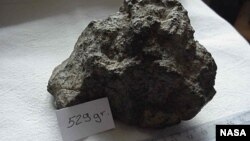New research by scientists at Oxford University in England has revealed that Mars may have also had an oxygen-rich atmosphere about four billion years ago, nearly 1.5 billion years before Earth developed its atmospheric oxygen.
The scientists, led by Professor Bernard Wood, first studied the chemical composition of Martian meteorites that fell to Earth, which they say probably came from the deep interior of Mars. They made a similar examination of rocks that were found on the surface of Mars with data provided by NASA's 'Spirit' rover. After comparing the composition of both forms of Martian rock, they found that those from the surface came from a more oxygen-rich environment.
Wood described the Martian rocks from meteorites as geologically 'young', around 180 million to 1.4 billion years old, and those found and analyzed by the Spirit rover was from what was said to be very old part of Mars, more than 3.7 billion years old.
The principal difference in chemical composition between the meteorite and surface rocks that he and his team noticed was in the concentration of nickel.
According to their analysis, the surface rocks had about five times as much nickel as the Martian meteorite, something they thought was puzzling, and made them wonder whether the meteorites are typical volcanic products of the red planet.
“What we have shown is that both meteorites and surface volcanic rocks are consistent with similar origins in the deep interior of Mars, but that the surface rocks come from a more oxygen-rich environment, probably caused by recycling of oxygen-rich materials into the interior,” said Wood.
Here on Earth, the method in which oxidized material can get recycled into the interior is something called subduction, which Wood describes as the process where old crust is pushed back down into the interior of the planet. The newly reintroduced oxidized material, he said, has an effect on the kind of material produced in the interior that is later brought back to the surface through volcanic activity.
The researchers believe that same processes took place on Mars during its early history, explaining why some Martian rock came from an oxygen rich environment while others did not.
Why is Mars the red planet?
Scientists say that the reddish hue of Mars surface is the result of oxidized iron – rust. This alone could show that the planet must have had oxygen available at least some time in its history.
So, where did the oxygen on come from?
Here on Earth, our oxygen was first produced as a result of the photosynthesis of early microbes. But that’s not how Mars got its oxygen.
“It would be very interesting if one could assert that the same thing, that microbes were involved on Mars, but in fact, the principle origin of oxygen was probably from the breakdown of water into oxygen plus hydrogen,” said Wood. “This happens in the atmosphere all the time, it’s happening on Earth right now; water is broken down into oxygen plus hydrogen and some hydrogen escapes from the Earth, leaving a small amount of remaining oxygen in the atmosphere.” The breakdown of the water into its basic two elements is caused by the Sun’s radiation.
Wood thinks that this same process had to have happened on Mars as well, if there was water vapor in the Martian atmosphere. He adds that the big difference is that on Mars, it’s easier for the hydrogen to escape, because of its weaker gravity.
“So, as long as there was water around on Mars, the water vapor in the atmosphere, there would be continuous production of oxygen due to the breakdown of water into oxygen plus hydrogen,” said Wood.
Losing oxygen
Unlike Earth though, Mars lost its atmospheric oxygen. Wood says this was due to its reaction to the surface of planet.
As mentioned earlier, Mars got its reddish hue due to the oxidation of iron contained in its rocks and soil. It was that oxidation process that eventually robbed Mars of its oxygen, according to Wood. Water that was present on the surface of early Mars also disappeared as a reaction with the rocks. “So, water is consumed, carbon dioxide is to some extent consumed and the oxygen is consumed by reaction between oceans and atmospheres and the rocks,” said Wood.
While the same processes are happening on Earth, the difference is that here there is continuous production of more water and carbon dioxide due to volcanic activity, so there is continuous replenishment of each.
Wood said that Mars didn’t have the same advantage of having these elements replenished. Unlike Earth, Mars, a smaller planet, quickly became much colder.
As it cooled down the amount of volcanism reduced, its water and carbon dioxide were not replaced efficiently.
Eventually, the amount of water and CO2 being replaced by this process would have become very small, and so gradually all of the water and carbon dioxide would have been consumed.
This would have caused a thinning of Mars’ atmosphere, making its surface even colder, producing a negative greenhouse effect, making it impossible for the planet to retain any of the Sun’s heat.
The study that chronicled the research and findings by Wood’s research team was published recently in the journal, Nature.
The scientists, led by Professor Bernard Wood, first studied the chemical composition of Martian meteorites that fell to Earth, which they say probably came from the deep interior of Mars. They made a similar examination of rocks that were found on the surface of Mars with data provided by NASA's 'Spirit' rover. After comparing the composition of both forms of Martian rock, they found that those from the surface came from a more oxygen-rich environment.
Wood described the Martian rocks from meteorites as geologically 'young', around 180 million to 1.4 billion years old, and those found and analyzed by the Spirit rover was from what was said to be very old part of Mars, more than 3.7 billion years old.
The principal difference in chemical composition between the meteorite and surface rocks that he and his team noticed was in the concentration of nickel.
According to their analysis, the surface rocks had about five times as much nickel as the Martian meteorite, something they thought was puzzling, and made them wonder whether the meteorites are typical volcanic products of the red planet.
“What we have shown is that both meteorites and surface volcanic rocks are consistent with similar origins in the deep interior of Mars, but that the surface rocks come from a more oxygen-rich environment, probably caused by recycling of oxygen-rich materials into the interior,” said Wood.
Here on Earth, the method in which oxidized material can get recycled into the interior is something called subduction, which Wood describes as the process where old crust is pushed back down into the interior of the planet. The newly reintroduced oxidized material, he said, has an effect on the kind of material produced in the interior that is later brought back to the surface through volcanic activity.
The researchers believe that same processes took place on Mars during its early history, explaining why some Martian rock came from an oxygen rich environment while others did not.
Why is Mars the red planet?
Scientists say that the reddish hue of Mars surface is the result of oxidized iron – rust. This alone could show that the planet must have had oxygen available at least some time in its history.
So, where did the oxygen on come from?
Here on Earth, our oxygen was first produced as a result of the photosynthesis of early microbes. But that’s not how Mars got its oxygen.
“It would be very interesting if one could assert that the same thing, that microbes were involved on Mars, but in fact, the principle origin of oxygen was probably from the breakdown of water into oxygen plus hydrogen,” said Wood. “This happens in the atmosphere all the time, it’s happening on Earth right now; water is broken down into oxygen plus hydrogen and some hydrogen escapes from the Earth, leaving a small amount of remaining oxygen in the atmosphere.” The breakdown of the water into its basic two elements is caused by the Sun’s radiation.
Wood thinks that this same process had to have happened on Mars as well, if there was water vapor in the Martian atmosphere. He adds that the big difference is that on Mars, it’s easier for the hydrogen to escape, because of its weaker gravity.
“So, as long as there was water around on Mars, the water vapor in the atmosphere, there would be continuous production of oxygen due to the breakdown of water into oxygen plus hydrogen,” said Wood.
Losing oxygen
Unlike Earth though, Mars lost its atmospheric oxygen. Wood says this was due to its reaction to the surface of planet.
As mentioned earlier, Mars got its reddish hue due to the oxidation of iron contained in its rocks and soil. It was that oxidation process that eventually robbed Mars of its oxygen, according to Wood. Water that was present on the surface of early Mars also disappeared as a reaction with the rocks. “So, water is consumed, carbon dioxide is to some extent consumed and the oxygen is consumed by reaction between oceans and atmospheres and the rocks,” said Wood.
While the same processes are happening on Earth, the difference is that here there is continuous production of more water and carbon dioxide due to volcanic activity, so there is continuous replenishment of each.
Wood said that Mars didn’t have the same advantage of having these elements replenished. Unlike Earth, Mars, a smaller planet, quickly became much colder.
As it cooled down the amount of volcanism reduced, its water and carbon dioxide were not replaced efficiently.
Eventually, the amount of water and CO2 being replaced by this process would have become very small, and so gradually all of the water and carbon dioxide would have been consumed.
This would have caused a thinning of Mars’ atmosphere, making its surface even colder, producing a negative greenhouse effect, making it impossible for the planet to retain any of the Sun’s heat.
The study that chronicled the research and findings by Wood’s research team was published recently in the journal, Nature.












